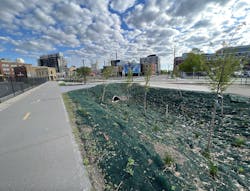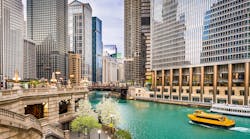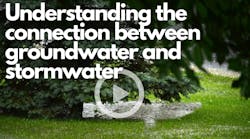Most communities throughout the United States were developed prior to nationwide stormwater standards introduced in the 1970s regulating water quantity and quality. Before these regulations, stormwater was managed by simply conveying it off-site as quickly as possible without considering the negative impacts it would have downstream. Increased rainfall intensity and precipitation has produced larger stormwater runoff volumes, resulting in frequent localized flooding events and impairments in our downstream natural resources.
Thankfully over the years, best management practices for stormwater have evolved. As climate concerns continue to grow, municipalities are becoming more environmentally conscious and more open to sustainable design. Trends in green infrastructure and low impact design are seeing increased popularity due to delivering on triple bottom line promises – environmental, economic and social benefits.
Incorporating green infrastructure (GI) and low impact development (LID) into designs has allowed the industry to help address water quality issues at the source rather than dealing with repercussions downstream. These practices have been around for decades and have proven to be successful in removing the first flush of pollutants and minimizing the impacts of more frequent storm events.
Green infrastructure is often defined as the range of measures that use plant or soil systems, permeable pavement, other permeable surfaces or substrates, stormwater harvest and reuse or landscaping to store, infiltrate or evapotranspiration stormwater and reduce flows to sewer systems or to surface waters. LID preserves and recreates natural landscape features, while minimizing hard surfaces to create functional and appealing site drainage. In terms of control measures, you can see how these two practices go hand in hand and have some overlap.
Green infrastructure is often a minor component of an overall larger project and is usually driven by regulations to meet project demands. In addition to reducing polluted stormwater runoff, these practices can also positively impact energy consumption, air quality, carbon reduction and sequestration, as well as property prices.
But what if we started to think of these practices as an amenity – where recreation and community health and vitality are just as important – and not just a necessity?
Digging into the TBL – Creature Comforts & Added Value
It is no secret that implementing LID is smart money management. A U.S. Environmental Protection Agency study of 17 case studies around the country found that, in most cases, total capital cost savings ranged from 15% to 80% when low impact development methods were used. But the benefits do not stop with the budget.
From an environmental perspective, green infrastructure’s primary benefit is enhancing the downstream water bodies, which in turn can reduce costs associated with combined sewer overflows and drinking water treatment. However, there are secondary benefits to creating LID, like lessening the heat island effect in more urbanized areas. The heat island effect can drive up energy use for residents, and local businesses, to keep homes and office buildings cool.
Taking out unnecessary impervious surfaces – like concrete, asphalt or buildings – and adding a more natural landscape helps prevent heat radiation. Many designs also incorporate trees (adding value) within urbanized areas so canopies can cover impervious areas that typical green infrastructure may not be able to reach – thus moderating the heat island effect.
Planting the Seed – Greener, More Complete Streets
Let us face it, the COVID-19 pandemic changed a lot of things, including altering transportation attitudes. Whether it is a greater desire to be outside in nature, more professionals working remotely, a combination of both, or something completely different, municipalities are seeing new momentum for cycling and walking. Transportation is no longer only about the driving experience; it is for all types of users.
This newfound enthusiasm for alternative modes of transportation is creating increased demand for complete streets. Designed and operated to enable safe use and support mobility for all users, this growing trend accommodates all forms of transportation from pedestrian infrastructure and traffic calming measures to bicycle and public transportation accommodations. And the best part for water resources engineers? Incorporating more green than gray.
Adding in green infrastructure can also have positive social impacts, from improved aesthetics to expanded recreational opportunities for communities. As a bonus to decreased budgetary expenses, many studies tout the positive impact green spaces can have on your mood and mental health. This checks off the third piece to the triple bottom line puzzle. Implementing green infrastructure and creating green space adjacent to sidewalks offers a soothing and more calm impact on the user experience. Narrower roadways punctuated with green infrastructure can create a natural barrier between pedestrians/bicyclists and drivers, establishing a safer user experience for everyone.
The Urban Street Stormwater Guide from the National Association of City Transportation Officials discusses how a flooded street is not a complete street. Think about it – during storm events, those walking, bicycling and transit users are the first to encounter barriers and often, lose access to the street. They are also the last to regain it. And it makes sense, doesn’t it? If we are moving to more inclusive and interactive communities, proper stormwater design is vital, otherwise, livability will suffer every time Mother Nature lets loose.
Imagine the Possibilities
Take the Downtown East reconstruction project recently completed in the city of Minneapolis, Minnesota. This was a fully impervious section of road in need of a transformation. Rather than reconstructing the road back to its original width, the city, working with stakeholders in the area, reimagined this space as a complete street.
First, some parking lanes were removed to reduce the impervious surface. Planters adjacent to the road and other green spaces were added, enhancing the sidewalk, and creating a bike trail connection to make the corridor more inviting.
The city also owned a small parcel of property adjacent to the road that had been used as a parking lot, which needed rehabilitation. The city took advantage of this space to create a mini stormwater park. This concrete conversion provided connectivity to two popular multi-use trails on both sides of the Downtown East reconstruction project. Thinking outside the box created a more enjoyable, and safer, experience for pedestrians and cyclists.
This modest type of low impact design is just one of the ways a city can take advantage of a space that is no longer contributing to the good of the community.
Where could you do something similar in your community?
Does your municipality have unused space in need of a refresh? Consider green infrastructure and low impact design to not only alleviate stormwater woes, but also bring a stronger sense of community to those who call that neighborhood home. This is not just an eco-friendly trend; it is a better way of life.






